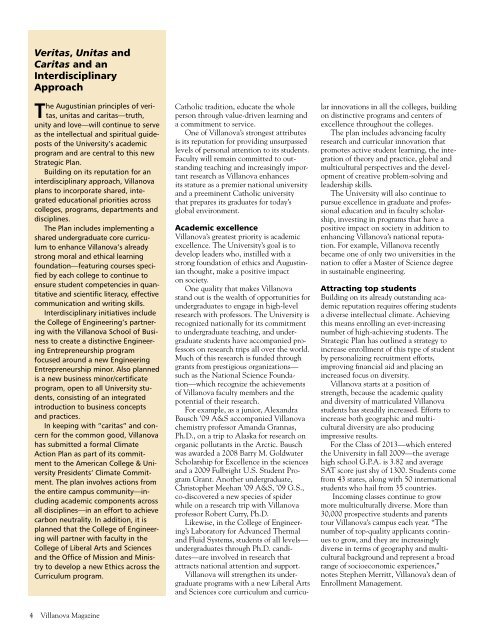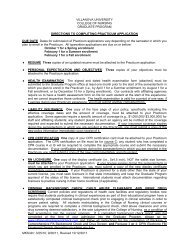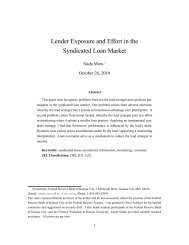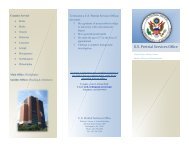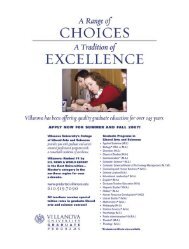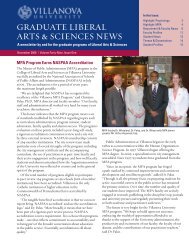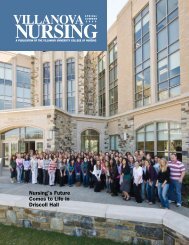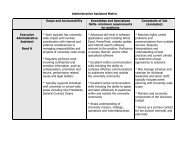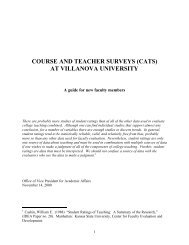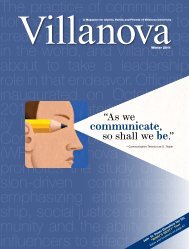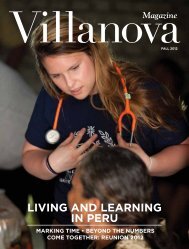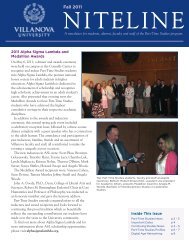Looking to the Future with Villanova's Strategic Plan
Looking to the Future with Villanova's Strategic Plan
Looking to the Future with Villanova's Strategic Plan
Create successful ePaper yourself
Turn your PDF publications into a flip-book with our unique Google optimized e-Paper software.
Veritas, Unitas and<br />
Caritas and an<br />
Interdisciplinary<br />
Approach<br />
The Augustinian principles of veritas,<br />
unitas and caritas—truth,<br />
unity and love—will continue <strong>to</strong> serve<br />
as <strong>the</strong> intellectual and spiritual guideposts<br />
of <strong>the</strong> University’s academic<br />
program and are central <strong>to</strong> this new<br />
<strong>Strategic</strong> <strong>Plan</strong>.<br />
Building on its reputation for an<br />
interdisciplinary approach, Villanova<br />
plans <strong>to</strong> incorporate shared, integrated<br />
educational priorities across<br />
colleges, programs, departments and<br />
disciplines.<br />
The <strong>Plan</strong> includes implementing a<br />
shared undergraduate core curriculum<br />
<strong>to</strong> enhance Villanova’s already<br />
strong moral and ethical learning<br />
foundation—featuring courses specified<br />
by each college <strong>to</strong> continue <strong>to</strong><br />
ensure student competencies in quantitative<br />
and scientific literacy, effective<br />
communication and writing skills.<br />
Interdisciplinary initiatives include<br />
<strong>the</strong> College of Engineering’s partnering<br />
<strong>with</strong> <strong>the</strong> Villanova School of Business<br />
<strong>to</strong> create a distinctive Engineering<br />
Entrepreneurship program<br />
focused around a new Engineering<br />
Entrepreneurship minor. Also planned<br />
is a new business minor/certificate<br />
program, open <strong>to</strong> all University students,<br />
consisting of an integrated<br />
introduction <strong>to</strong> business concepts<br />
and practices.<br />
In keeping <strong>with</strong> “caritas” and concern<br />
for <strong>the</strong> common good, Villanova<br />
has submitted a formal Climate<br />
Action <strong>Plan</strong> as part of its commitment<br />
<strong>to</strong> <strong>the</strong> American College & University<br />
Presidents’ Climate Commitment.<br />
The plan involves actions from<br />
<strong>the</strong> entire campus community—including<br />
academic components across<br />
all disciplines—in an effort <strong>to</strong> achieve<br />
carbon neutrality. In addition, it is<br />
planned that <strong>the</strong> College of Engineering<br />
will partner <strong>with</strong> faculty in <strong>the</strong><br />
College of Liberal Arts and Sciences<br />
and <strong>the</strong> Office of Mission and Ministry<br />
<strong>to</strong> develop a new Ethics across <strong>the</strong><br />
Curriculum program.<br />
Catholic tradition, educate <strong>the</strong> whole<br />
person through value-driven learning and<br />
a commitment <strong>to</strong> service.<br />
One of Villanova’s strongest attributes<br />
is its reputation for providing unsurpassed<br />
levels of personal attention <strong>to</strong> its students.<br />
Faculty will remain committed <strong>to</strong> outstanding<br />
teaching and increasingly important<br />
research as Villanova enhances<br />
its stature as a premier national university<br />
and a preeminent Catholic university<br />
that prepares its graduates for <strong>to</strong>day’s<br />
global environment.<br />
Academic excellence<br />
Villanova’s greatest priority is academic<br />
excellence. The University’s goal is <strong>to</strong><br />
develop leaders who, instilled <strong>with</strong> a<br />
strong foundation of ethics and Augustinian<br />
thought, make a positive impact<br />
on society.<br />
One quality that makes Villanova<br />
stand out is <strong>the</strong> wealth of opportunities for<br />
undergraduates <strong>to</strong> engage in high-level<br />
research <strong>with</strong> professors. The University is<br />
recognized nationally for its commitment<br />
<strong>to</strong> undergraduate teaching, and undergraduate<br />
students have accompanied professors<br />
on research trips all over <strong>the</strong> world.<br />
Much of this research is funded through<br />
grants from prestigious organizations—<br />
such as <strong>the</strong> National Science Foundation—which<br />
recognize <strong>the</strong> achievements<br />
of Villanova faculty members and <strong>the</strong><br />
potential of <strong>the</strong>ir research.<br />
For example, as a junior, Alexandra<br />
Bausch ’09 A&S accompanied Villanova<br />
chemistry professor Amanda Grannas,<br />
Ph.D., on a trip <strong>to</strong> Alaska for research on<br />
organic pollutants in <strong>the</strong> Arctic. Bausch<br />
was awarded a 2008 Barry M. Goldwater<br />
Scholarship for Excellence in <strong>the</strong> sciences<br />
and a 2009 Fulbright U.S. Student Program<br />
Grant. Ano<strong>the</strong>r undergraduate,<br />
Chris<strong>to</strong>pher Meehan ’09 A&S, ’09 G.S.,<br />
co-discovered a new species of spider<br />
while on a research trip <strong>with</strong> Villanova<br />
professor Robert Curry, Ph.D.<br />
Likewise, in <strong>the</strong> College of Engineering’s<br />
Labora<strong>to</strong>ry for Advanced Thermal<br />
and Fluid Systems, students of all levels—<br />
undergraduates through Ph.D. candidates—are<br />
involved in research that<br />
attracts national attention and support.<br />
Villanova will streng<strong>the</strong>n its undergraduate<br />
programs <strong>with</strong> a new Liberal Arts<br />
and Sciences core curriculum and curricu-<br />
lar innovations in all <strong>the</strong> colleges, building<br />
on distinctive programs and centers of<br />
excellence throughout <strong>the</strong> colleges.<br />
The plan includes advancing faculty<br />
research and curricular innovation that<br />
promotes active student learning, <strong>the</strong> integration<br />
of <strong>the</strong>ory and practice, global and<br />
multicultural perspectives and <strong>the</strong> development<br />
of creative problem-solving and<br />
leadership skills.<br />
The University will also continue <strong>to</strong><br />
pursue excellence in graduate and professional<br />
education and in faculty scholarship,<br />
investing in programs that have a<br />
positive impact on society in addition <strong>to</strong><br />
enhancing Villanova’s national reputation.<br />
For example, Villanova recently<br />
became one of only two universities in <strong>the</strong><br />
nation <strong>to</strong> offer a Master of Science degree<br />
in sustainable engineering.<br />
Attracting <strong>to</strong>p students<br />
Building on its already outstanding academic<br />
reputation requires offering students<br />
a diverse intellectual climate. Achieving<br />
this means enrolling an ever-increasing<br />
number of high-achieving students. The<br />
<strong>Strategic</strong> <strong>Plan</strong> has outlined a strategy <strong>to</strong><br />
increase enrollment of this type of student<br />
by personalizing recruitment efforts,<br />
improving financial aid and placing an<br />
increased focus on diversity.<br />
Villanova starts at a position of<br />
strength, because <strong>the</strong> academic quality<br />
and diversity of matriculated Villanova<br />
students has steadily increased. Efforts <strong>to</strong><br />
increase both geographic and multicultural<br />
diversity are also producing<br />
impressive results.<br />
For <strong>the</strong> Class of 2013—which entered<br />
<strong>the</strong> University in fall 2009—<strong>the</strong> average<br />
high school G.P.A. is 3.82 and average<br />
SAT score just shy of 1300. Students come<br />
from 43 states, along <strong>with</strong> 50 international<br />
students who hail from 35 countries.<br />
Incoming classes continue <strong>to</strong> grow<br />
more multiculturally diverse. More than<br />
30,000 prospective students and parents<br />
<strong>to</strong>ur Villanova’s campus each year. “The<br />
number of <strong>to</strong>p-quality applicants continues<br />
<strong>to</strong> grow, and <strong>the</strong>y are increasingly<br />
diverse in terms of geography and multicultural<br />
background and represent a broad<br />
range of socioeconomic experiences,”<br />
notes Stephen Merritt, Villanova’s dean of<br />
Enrollment Management.<br />
4 Villanova Magazine


